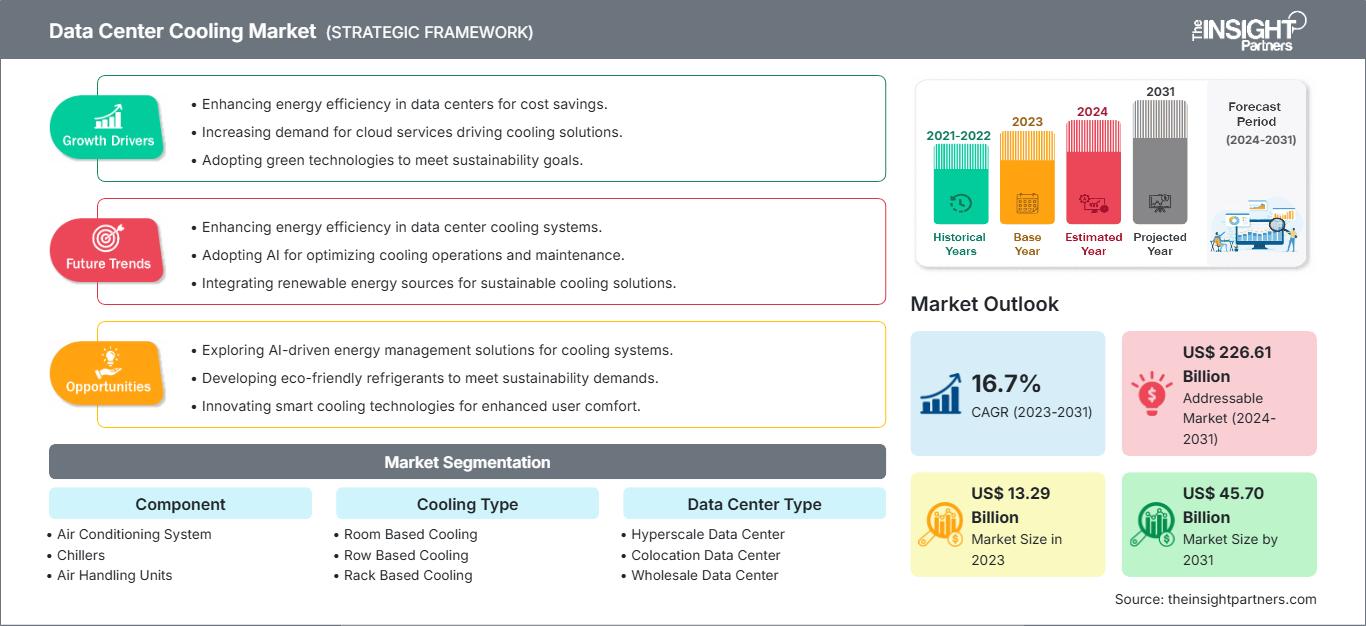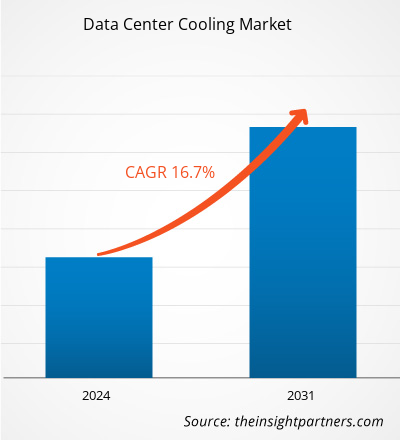データセンター冷却市場規模は、2023年の132億9,000万米ドルから2031年には457億米ドルに達すると予想されています。市場は2023年から2031年にかけて16.7%のCAGRを記録すると予測されています。AIに最適化された冷却とより静かな冷却ソリューションは、市場に新たなトレンドをもたらす可能性があります。
データセンター冷却市場分析
コンピューティング集約型ワークロードの需要増加とデータセンターへの高額投資が、データセンター冷却市場を牽引しています。市場では、高性能コンピューティング(HPC)の利用が増えており、これがデータセンター冷却ソリューションの需要に貢献しています。さらに、Intel CorporationとSubmerが協力して、高熱設計電力(TDP)のチップを冷却するためのソリューションを開発するなど、大手企業による戦略的イニシアチブの増加も、市場の成長に貢献しています。さらに、エネルギー効率が高く堅牢なデータセンター冷却ソリューションへの需要の高まりと、インターネット、クラウドコンピューティング、AI、IoT、ビッグデータなどのテクノロジーの普及拡大が相まって、データセンターの液冷システムの採用が促進されると予測されています。液冷技術の進歩とデータセンター冷却ロボットの増加により、市場は予測期間中に成長すると見込まれています。
データセンター冷却市場概要
データセンター冷却とは、データセンター内の温度を最適に保ち、IT機器の正常な動作を確保するためのシステムと技術を指します。IT機器は動作中に熱を発生し、極端な熱は機器の誤動作や故障につながる可能性があります。こうした課題を克服するため、データセンター冷却の需要は急速に増加しています。冷却システムは、データセンター・インフラストラクチャの信頼性とパフォーマンスを維持するために不可欠です。データセンター冷却は、データセンター内に収容されるすべての機器の最適な動作環境を構築し、維持する上で重要な役割を果たします。データセンターは世界の電力の約3%を消費しており、その結果、大量の熱が発生します。効率的な冷却システムを実装しないと、IT 機器の故障、高額な損害、運用停止のリスクが大幅に高まります。
要件に合わせてレポートをカスタマイズ
レポートの一部、国レベルの分析、Excelデータパックなどを含め、スタートアップ&大学向けに特別オファーや割引もご利用いただけます(無償)
データセンター冷却市場: 戦略的洞察

-
このレポートの主要な市場動向を入手してください。この無料サンプルには、市場動向から見積もりや予測に至るまでのデータ分析が含まれます。
データセンター冷却市場の推進要因と機会
計算集約型ワークロードの需要増加が市場成長を後押し
さまざまな業界で、顧客体験の向上、サイバーセキュリティ対策の強化、ビジネスプロセスの改革のために AI と機械学習が取り入れられています。これらのテクノロジーの導入と価値の最適化には、ますます複雑化するワークロードを処理できる堅牢なインフラストラクチャが必要です。AI モデルのトレーニングの計算集約型の性質により、AI やその他の高度なアプリケーションの高まる需要を満たすためにハードウェアが進化しました。たとえば、2024 年 4 月、Lenovo は、エッジからクラウドまでのハイブリッド AI イノベーションを推進するための、専用の AI 中心のインフラストラクチャ システムとソリューションの包括的な新しいスイートを発表しました。Lenovo は、複数の環境と業界の計算集約型ワークロード向けに、GPU を豊富に搭載し熱効率に優れたソリューションを提供しています。金融サービスおよびヘルスケア業界のお客様は、極めて高いI/O帯域幅を必要とする膨大なデータセットを管理しており、Lenovoは重要なデータの管理に不可欠なITインフラストラクチャソリューションを提供しています。
企業がAIと機械学習の可能性を活用し続ける中で、コンピューティングハードウェアの継続的な進化は、膨大な量のデータを効率的に処理・活用する上で極めて重要な役割を果たし、組織が情報に基づいた意思決定を行い、データ資産を分析できるようにします。コンピューティング能力の向上とハードウェアへの需要の増加は、電力消費と発熱の増加をもたらしています。その結果、高密度ハードウェアの使用に起因するデータセンターの温度上昇により、これらの熱問題を緩和するための重要な技術として、液冷の重要性が浮き彫りになりました。このように、コンピューティング集約型ワークロードの需要の増加が、データセンター冷却市場を牽引しています。
液冷技術の進歩
液冷は、高性能コンピューティング(HPC)およびデータセンター業界の要件を満たす最適なソリューションとして登場しました。液冷は継続的な空気循環の必要性をなくすことで、ユーティリティ消費を大幅に削減し、それによって施設のエネルギー効率を高めます。 液冷技術は人気のソリューションとして登場しており、データセンターの約40%がそれを利用しています。 企業は、液冷技術の進歩に参加するために戦略的パートナーシップを結んでいます。 たとえば、三菱重工業株式会社(MHI)とZutaCore, Inc.は、エネルギー効率とゼロエミッションを達成するために、データ業界向けの持続可能な液冷ソリューションを推進するために、2023年9月に戦略的パートナーシップを結びました。 このコラボレーションには、MHIのZutaCoreへの投資とホワイトラベル販売契約が含まれており、ZutaCoreのHyperCool誘電体直接液冷技術と、MHIの幅広い製品ラインと技術的専門知識を世界規模で組み合わせています。 ZutaCoreのHyperCoolテクノロジーは、データ業界の持続可能性と増大し続けるコンピューティングパワーの間のギャップを埋めることを目指す、水を使用しないダイレクトオンチップ液冷ソリューションです。この技術は、コンピューティング能力を10倍に向上させ、総所有コスト(TCO)を50%削減し、熱を100%再利用するとともに、CO2排出量も削減します。この技術は、放熱に実質的な制限がなく、大量の熱をチップから効果的かつ安全に排出するように設計されています。また、エネルギー、水、土地などの希少資源の消費を削減し、設備投資と運用コストを削減することも目指しています。このパートナーシップは、エネルギー効率に不可欠な持続可能な液体冷却ソリューションの成長を促進することを目的としています。このコラボレーションによって提供される包括的なソリューションは、高性能コンピューティングのワークロード、サーバーの高密度化、データセンターの持続可能性に前例のないメリットをもたらします。
データセンター冷却市場レポートのセグメンテーション分析
データセンター冷却市場分析の導出に貢献した主要なセグメントは、コンポーネント、冷却タイプ、データセンタータイプ、および業界垂直です。
- コンポーネントの点では、市場はチラー、空調システム、熱交換器、冷却塔、空調ユニット、加湿器などに分割されています。2023年には、空調システムセグメントが市場を支配しました。
- 冷却タイプ別では、市場は部屋ベースの冷却、ラックベースの冷却、および列ベースの冷却に分類されます。2023年には、部屋ベースの冷却セグメントが市場を支配しました。
- データセンタータイプに基づいて、データセンター冷却市場は、エンタープライズデータセンター、コロケーションデータセンター、卸売データセンター、およびハイパースケールデータセンターに分割されています。 2023年には、ハイパースケールデータセンターセグメントが市場を支配しました。
- 業種別では、市場はBFSI、製造、ITおよび通信、メディアおよびエンターテイメント、小売、政府および防衛、ヘルスケア、エネルギーなどに分類されています。2023年にはITおよび通信セグメントが市場を支配しました。
地域別データセンター冷却市場シェア分析
データセンター冷却市場は、北米、ヨーロッパ、アジア太平洋(APAC)、中東およびアフリカ(MEA)、南米および中米の5つの主要地域に分割されています。2023年には北米が市場を支配し、それに続いてヨーロッパとAPACが続きました。
北米のデータセンター冷却市場は、データセンター業界の台頭と、費用対効果が高く環境に優しいデータセンター冷却ソリューションの採用増加により、大幅に成長しています。市場プレーヤーは、技術的に高度なコンピューティングソリューションの需要に応えるために革新的で高度なソリューションを導入しており、市場の成長をさらに促進しています。たとえば、2023 年 11 月、Vertiv は、北米でのコンピューティングの迅速な導入に対する需要の高まりに対応するために構築されたプレハブ モジュラー データ センターである Vertiv SmartMod Max CW を発表しました。
データセンター冷却市場の地域別分析
予測期間を通じてデータセンター冷却市場に影響を与える地域的な傾向と要因については、The Insight Partnersのアナリストが詳細に説明しています。このセクションでは、北米、ヨーロッパ、アジア太平洋、中東・アフリカ、中南米におけるデータセンター冷却市場のセグメントと地域についても説明します。
データセンター冷却市場レポートの範囲
| レポート属性 | 詳細 |
|---|---|
| の市場規模 2023 | US$ 13.29 Billion |
| 市場規模別 2031 | US$ 45.70 Billion |
| 世界的なCAGR (2023 - 2031) | 16.7% |
| 過去データ | 2021-2022 |
| 予測期間 | 2024-2031 |
| 対象セグメント |
By コンポーネント
|
| 対象地域と国 |
北米
|
| 市場リーダーと主要企業の概要 |
|
データセンター冷却市場のプレーヤー密度:ビジネスダイナミクスへの影響を理解する
データセンター冷却市場は、消費者の嗜好の変化、技術の進歩、製品メリットへの認知度の高まりといった要因によるエンドユーザー需要の増加に牽引され、急速に成長しています。需要の増加に伴い、企業は製品ラインナップの拡充、消費者ニーズへの対応のための革新、そして新たなトレンドの活用を進めており、これが市場成長のさらなる加速につながっています。

- 入手 データセンター冷却市場 主要プレーヤーの概要
データセンター冷却市場のニュースと最近の動向
データセンター冷却市場は、主要な企業出版物、協会データ、データベースなどの一次調査と二次調査を経て定性的および定量的データを収集することで評価されます。データセンター冷却市場の動向のいくつかを以下に示します。
- 三菱重工業株式会社(MHI)は、液浸冷却(25kVA)、空冷(8kVA)、水冷(8kVA)の3種類の冷却方式を採用したサーバーを同時に収容可能な液浸/空冷ハイブリッド冷却システムを備えた、新しい40kVAクラスの12フィートコンテナ型データセンターを開発しました。今回開発されたデータセンターは、2021年から開発を進めてきたコンテナ型液浸冷却データセンターの後継機です。用途(電力密度)に応じて冷却方式が異なるサーバーを同時に搭載できるため、コンピュータネットワークの周辺(エッジ)でデータを処理するエッジコンピューティング向けに、多様なサーバーや機器を収容できます。
(出典:三菱重工業株式会社、プレスリリース、2023年10月)
- ミッションクリティカル空調のグローバルスペシャリストであるSTULZは、液体冷却ソリューションにおける熱交換効率を最大化するように設計された革新的な新型冷媒管理・分配ユニット(CDU)であるCyberCool CMUの発売を発表しました。
(出典:STULZ、プレスリリース、2024年3月)
データセンター冷却市場レポートの対象範囲と成果物
「データセンター冷却市場規模と予測「データセンター冷却市場レポート(2021~2031年)」では、以下の分野を網羅した詳細な市場分析を提供しています。
- データセンター冷却市場の規模と予測(対象範囲に含まれるすべての主要市場セグメントについて、世界、地域、国レベルで)
- データセンター冷却市場の動向、および推進要因、制約、主要な機会などの市場動向
- 詳細なPEST分析とSWOT分析
- 主要な市場動向、世界および地域の枠組み、主要プレーヤー、規制、最近の市場動向を網羅したデータセンター冷却市場分析
- 市場集中、ヒートマップ分析、主要プレーヤー、データセンター冷却市場の最近の動向を網羅した業界展望と競争分析
- 詳細な企業プロファイル
- 過去2年間の分析、基準年、CAGRによる予測(7年間)
- PEST分析とSWOT分析
- 市場規模価値/数量 - 世界、地域、国
- 業界と競争環境
- Excel データセット
最新レポート
関連レポート
お客様の声
購入理由
- 情報に基づいた意思決定
- 市場動向の理解
- 競合分析
- 顧客インサイト
- 市場予測
- リスク軽減
- 戦略計画
- 投資の正当性
- 新興市場の特定
- マーケティング戦略の強化
- 業務効率の向上
- 規制動向への対応






















 無料サンプルを入手 - データセンター冷却市場
無料サンプルを入手 - データセンター冷却市場